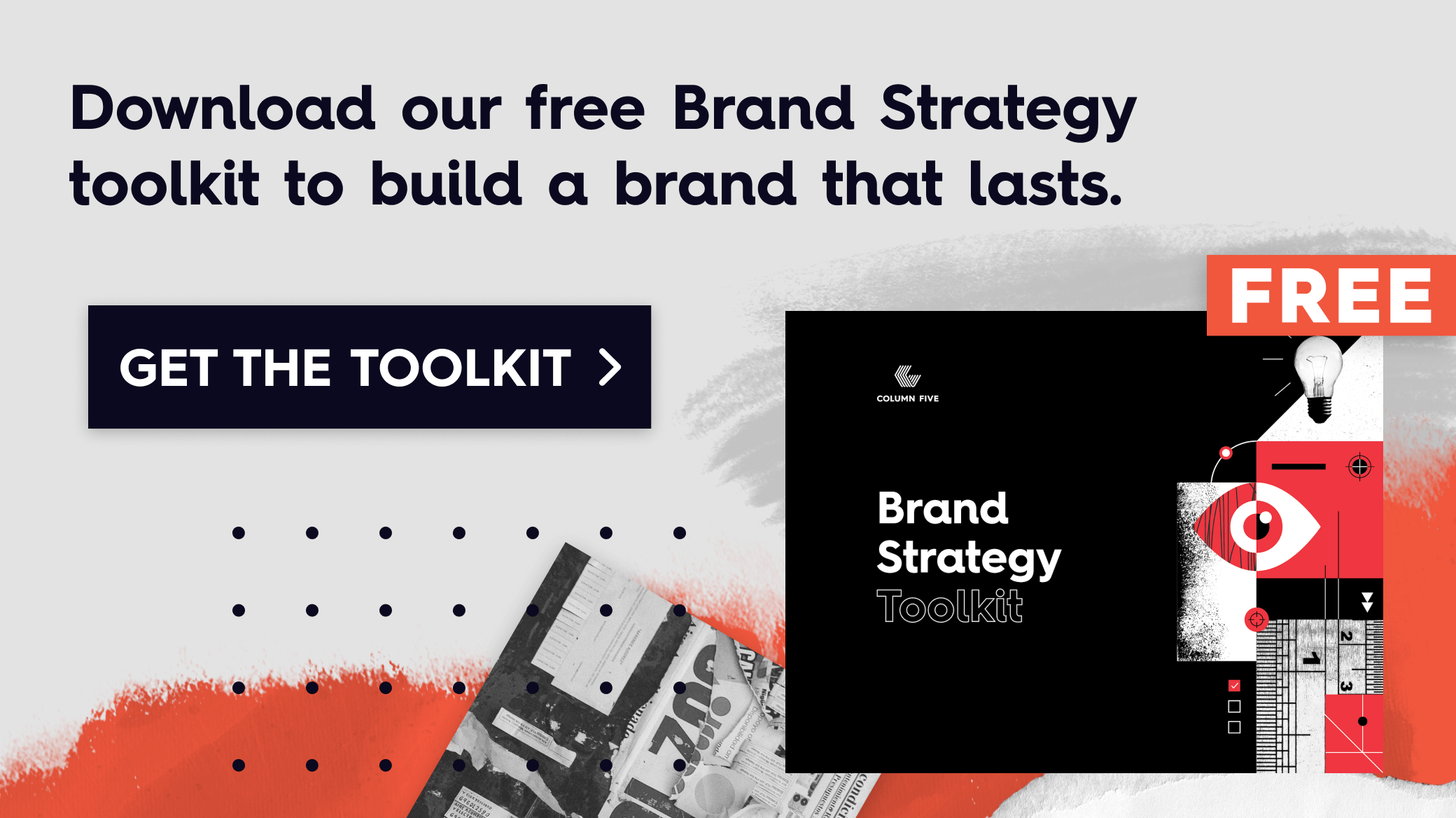Content marketing is tough for every brand, whether you’re B2B, B2C, a fresh startup, or an established Fortune 500. And, yes, marketing is tough even if you’re a content strategy agency that’s immersed in the practice day in, day out. But good content is the only way to effectively position yourself in the market, tell a compelling brand story, and connect with the audience you have and—most importantly—want. Want proof? Today, we’re sharing the story of how we revamped our stale content strategy to establish our expertise in a new area, capture a new audience, and turn those clicks into revenue—one piece of content at a time.
The Need for a New Content Marketing Strategy
Back in 2018, we found ourselves at a crossroads. We had been in the content marketing game for nearly a decade, amassed a notable list of clients, and produced creative work we were proud of across the board. We had a steady stream of clients, and we felt confident in our ability to do what they asked.
But we began to notice a problem emerging in kick-off call after kick-off call. Clients were coming to us for one-off content marketing pieces—a video, an interactive, a website, etc. But when we asked about their core brand or wanted to learn more about their content strategy to ensure our content would hit their goals, they couldn’t clearly articulate who they were or what they were really trying to achieve.
We soon realized that they had no brand strategy (to guide their business) or content strategy (to support their brand strategy). That was why they were truly struggling to create effective content and wasting their dollars while doing it. They didn’t really need our hands to create good content marketing; they needed our minds to develop their brand strategy and/or content strategy.
Unfortunately, having built our reputation as A+ content creators over the last decade, they didn’t see us as strategists (and, frankly, didn’t realize how desperately they needed us to do this type of work for them). This was clear in the fact that only 10% of our clients worked with us in a strategic capacity at the time. So we made an ambitious 3-year goal to reposition ourselves as a strategic agency and, as a result, increase our brand and content strategy engagements to 90% of our total bookings.
How would we do that? By creating a fresh content strategy for ourselves—one that would communicate the value of brand and content strategy to the right audience, establish our expertise, and convince people that we were the agency to hire for both.
The Plan: Credibility Through Content
Our biggest lead generator has always been organic traffic. Previously, we built our SEO strategy around the particular services we offered (targeting keywords like infographics, motion graphics, etc.). We ranked highly for these terms, and they served us very well. But, after auditing our content, we realized we had practically no thought leadership related to higher-level brand and content strategy. To fill this gap, we decided to build a fresh content pillar to educate our audience about these strategy-focused topics, rank for targeted keywords, and plant ourselves (and our perspective) firmly in the industry.
To make this strategy work, however, we needed three key elements.
1) The Framework
Before we did anything, we needed to align our perspective about brand (and how content strategy connects to it) internally. Without this core perspective, we knew we couldn’t produce content that would provide real value to our desired audience, so we went back to the books—literally.
We did a massive content deep dive, consuming every book and article on branding, brand strategy, brand development, and so on. We wanted to understand how everyone else was talking about these concepts, what they were missing, and how we could make a splash with a new perspective. Lucky for us, we found much of this content to be lacking.
Every framework to create a brand strategy was either too vague, too complicated, or too outdated. We decided we needed to start from scratch to create a clean, simple, streamlined brand framework to put into practice with our clients and share with the world.
After plenty of passionate debates, Post-it note brainstorms, revisions, and more debates, we finally produced an airtight framework we could stand behind—and confidently communicate through our content.
2) The Guide
To educate our audience on the value of brand strategy, communicate our perspective in plain English, and rank for the “brand strategy” keyword, we launched our new content pillar with the ultimate guide to brand strategy, a comprehensive guide and free toolkit (featuring 10+ templates). This pillar page would help us educate our audience on the value of brand strategy, while the toolkit would function as a valuable lead generator to help them take the next step to create a strategy.

3) Supporting Content
In addition to our main pillar piece, we wanted to create a rich ecosystem of supplemental content that covered brand strategy from every angle. So we focused our efforts on two key areas, specifically:
- Keyword content: To educate our audience and reinforce the value of brand strategy, we brainstormed cluster topics that addressed a variety of pain points and questions we knew our audience struggled with. This resulted in 35+ keyword-related articles on everything from creating a value proposition to designing a logo. We interlinked these articles with the pillar page and other relevant topics to create a rich content path that people could enter at any point. This allowed us to further expand on our ideas, capture that keyword-related traffic, and move our audience along the path to purchase article by article.
- Sales collateral: With our new brand strategy messaging, we needed to overhaul our sales decks to walk prospects through our perspective, communicate it clearly, and convince them to start their brand strategy with us—yesterday. Not only did this help us tell our own brand story more effectively (positioning us as a strategic agency) but the conversations helped us refine our thinking even more.
This entire approach was an ambitious undertaking for our team, requiring us to do a lot of deep work, test our theories on ourselves, and challenge each other (and even our clients) throughout. Naturally, with an ambitious goal of increasing our brand and content strategy bookings to 90% in 3 years, we felt enormous pressure to make it work. Luckily, it paid off in so many ways.
The Results
In content marketing, results take time. But with steady attention and focus, we know firsthand how successful a sound content strategy can be—when it’s aligned to your brand goals. In three years, we’re proud to say we increased our brand and content strategy bookings from 10% of our total bookings to 90% of our bookings–an astounding 160% increase overall. These numbers are awesome, but it’s important to note that it didn’t happen all at once. This success was buoyed by every single part of our revamped content strategy.
1) The brand strategy guide: Since publishing, this has become our #2 most popular article of all time. Aside from many glowing comments (and two real-life voicemails from readers who were so impressed they wanted to call to thank us for it), we’re most proud that we made a simple, elegant, and easy-to-read guide that has helped hundreds of thousands of people understand the value of brand strategy. (Note: In 2021 we reoptimized the post, updating it to reflect our current perspective and increased page views 180%.)
- Ranks page 1 for “Brand Strategy”
- 350K+ pageviews
Best of all, this guide quickly became our most referenced piece of content in sales conversations. There is nothing better than hearing prospects adopt your terminology and buy into your perspective—before they even become a client.
2) The brand strategy toolkit: People can talk about brand strategy all day long, and many of the resources we first turned to certainly did, but they often did so in abstract and esoteric ways. We created the Brand Strategy toolkit to give our audience something tangible and practical to help them make the most of the guide, and in the process, we have earned thousands of loyal newsletter subscribers and fans.
- 42,314 toolkit downloads (#1 most popular resource)
3) The supporting content: Our cluster content has consistently given us fantastic results, allowing us to increase our reach and rank for a variety of keywords. By aligning both our editorial content and sales decks, we were able to tell a consistent story and create a seamless brand experience, which has led to us not only attracting more of the kind of business we want but closing more of it too.
- Page 1 ranking for target keywords, including terms such as brand heart, brand messaging framework, brand name, brand strategy template, tagline, branding strategy, brand identity, brand story, brand message, etc.
- 35% of our site traffic is now generated by brand strategy-related content.
4) The bookings: Most importantly, we were able to attract and close brand and content strategy engagements like never before. Through this content strategy alone, we effectively repositioned our brand from a vendor for hire to a strategic partner.
This validated our hypothesis that clients desperately needed strategic guidance (especially our fast-growing SaaS clients) but just didn’t know who to turn to. Ultimately, we saw not only a shift in the type of engagement we attracted but significant growth. Though it wasn’t always linear, we saw about a 30% increase in our new business sales after the first year of this revised content strategy. (This year, we’re on track to more than 3X that figure.) This has led to a fundamental change in the evolution of our business model, as well as our hiring practices, helping us serve our clients in even more effective ways.
One final benefit from this content strategy experiment is the ability to confidently use ourselves as a case study. By eating our own dogfood, we put ourselves through the wringer, made mistakes, and stuck with it enough to share our hard-won wisdom with our clients—something we know they find meaningful and valuable.
The Takeaways
While we are proud to share this success, we know how challenging marketing is—no matter your business. So here are the biggest lessons we’ve learned from this process.
1) Stop doing what you’ve always done because that’ll get you what you’ve always had.
Even though our early content strategy was successful, it was no longer aligned to our own brand strategy goals. We weren’t talking to the right people about the right things, we weren’t generating interest, and we certainly weren’t closing the type of deals we wanted to. We were stuck in a rut. But by re-examining our own brand strategy, clarifying our brand goals, and creating a successful content strategy to support them, we were able to do exactly what we were trying sell to our clients.
Tip: To make sure your own content strategy is successful (and aligned to your brand strategy), make sure to document your goals to keep everyone on the same page.
2) Get your house in order.
After reviewing our own content and the content other people had published, we identified the gaps in our messaging, as well as opportunities to create stronger, more streamlined content than what already existed. With this knowledge, we were able to build a strong framework to apply to our work, then turn it into compelling content that provided value to our audience and helped us achieve our brand goal of repositioning our agency as a strategic partner.
Tip: Use our free template to conduct a content audit to understand how you stack up against your competition—and how you can differentiate.
3) Take a strong stand.
If you want to create strong content, you need to take a strong stance—on whatever it is you’re talking about. For us, having seen how overly complicated (and unhelpful) so much brand strategy thought leadership was, we decided to change it. We built a framework from scratch, simplified the process, and made it as accessible as possible. This helped us plant our flag, demonstrate our expertise, and reinforce our value to our larger audience.
Tip: If you’re not sure how to provide value to your audience, use empathy. Think of their needs, wants, pain points, and desires, then brainstorm ways to speak authoritatively on those subjects.
Fortunately, this approach paid off for us in huge ways—and continues to. That said, content marketing is an ever-evolving practice. As your brand evolves, so must your strategy. It’s important to stay proactive, monitor what is and isn’t working, and continue to refine your approach to meet your audience where they’re at.
We are continuing to do just that, and we’re happy to help our partners do the same. If you need a success story of your own, find out what it’s like to work with us on a brand strategy engagement, or reach out directly. We’d love to help you become our next case study.





